Novel Color Change Film as a Time–Temperature Indicator Using Polydiacetylene/Silver Nanoparticles Embedded in Carboxymethyl Cellulose
Abstract
:1. Introduction
2. Materials and Methods
2.1. Materials
2.2. Preparation of PDA/AgNPs
2.3. Film Formation
2.4. Morphology of PDA/AgNP-Embedded CMC Films
2.5. Chemical Structure of PDA/AgNP-Embedded CMC Films
2.6. Determination of the Dynamic Parameters of Indicator Films
3. Results and Discussion
3.1. Color Change Behavior in PDA/AgNP-Embedded CMC Films
3.2. Morphology of PDA/AgNP-Embedded CMC Films
3.3. Characterization of PDA/AgNP-Embedded CMC Films
3.4. A Dynamic Parameter of a TTI Prototype Based on PDA/AgNP-Embedded CMC Film
4. Conclusions
Author Contributions
Funding
Acknowledgments
Conflicts of Interest
References
- Shimoni, E.; Anderson, E.; Labuza, T.P. Reliability of time-temperature indicators under temperature abuse. J. Food Sci. 2001, 66, 1337–1340. [Google Scholar] [CrossRef]
- Wandel, M.; Bugge, A. Environmental concern in consumer evaluation of food quality. Food Qual. Pref. 1997, 8, 19–26. [Google Scholar] [CrossRef]
- Giannakourou, M.; Koutsoumanis, K.; Nychas, G.; Taoukis, P. Field evaluation of the application of time temperature integrators for monitoring fish quality in the chill chain. Int. J. Food Microbiol. 2005, 102, 323–336. [Google Scholar] [CrossRef] [PubMed]
- Kim, M.J.; Jung, S.W.; Park, H.R.; Lee, S.J. Selection of an optimum pH-indicator for developing lactic acid bacteria-based time–temperature integrators (TTI). J. Food Eng. 2012, 113, 471–478. [Google Scholar] [CrossRef]
- Nopwinyuwong, A.; Kaisone, T.; Hanthanon, P.; Nandhivajrin, C.; Boonsupthip, W.; Pechyen, C.; Suppakul, P. Effects of nanoparticle concentration and plasticizer type on colorimetric behavior of polydiacetylene/silica nanocomposite as time-temperature indicator. Energy Procedia 2014, 56, 423–430. [Google Scholar] [CrossRef] [Green Version]
- Jelinek, R.; Ritenberg, M. Polydiacetylenes–recent molecular advances and applications. RSC Adv. 2013, 3, 21192–21201. [Google Scholar] [CrossRef]
- Nopwinyuwong, A.; Boonsupthip, W.; Pechyen, C.; Suppakul, P. Formation of polydiacetylene/silica nanocomposite as a colorimetric indicator: Effect of time and temperature. Adv. Polymer Technol. 2013, 32, E724–E731. [Google Scholar] [CrossRef]
- Traiphol, N.; Rungruangviriya, N.; Potai, R.; Traiphol, R. Stable polydiacetylene/ZnO nanocomposites with two-steps reversible and irreversible thermochromism: The influence of strong surface anchoring. J. Colloid Interface Sci. 2011, 356, 481–489. [Google Scholar] [CrossRef]
- Kwon, Y.K.; Jung, J.M.; Lee, K.H. Preparation of polydiacetylene-attached TiO2 nanoparticles. Mol. Cryst. Liq. Cryst. 2007, 463, 263–269. [Google Scholar] [CrossRef]
- Alloisio, M.; Zappia, S.; Demartini, A.; Ottonelli, M.; Dellepiane, G.; Thea, S.; Zoppi, A.; Giorgetti, E.; Muniz-Miranda, M. Novel polydiacetylene-functionalized nanostructures for sensing applications. e-J. Surf. Sci. Nanotechnol. 2012, 10, 549–552. [Google Scholar] [CrossRef] [Green Version]
- Won, S.H.; Sim, S.J. Signal enhancement of a micro-arrayed polydiacetylene (PDA) biosensor using gold nanoparticles. Analyst 2012, 137, 1241–1246. [Google Scholar] [CrossRef] [PubMed]
- Nopwinyuwong, A.; Kitaoka, T.; Boonsupthip, W.; Pechyen, C.; Suppakul, P. Effect of cationic surfactants on characteristics and colorimetric behavior of polydiacetylene/silica nanocomposite as time–Temperature indicator. Appl. Surf. Sci. 2014, 314, 426–432. [Google Scholar] [CrossRef]
- Wang, Y.-C.; Lu, L.; Gunasekaran, S. Biopolymer/gold nanoparticles composite plasmonic thermal history indicator to monitor quality and safety of perishable bioproducts. Biosens. Bioelectron. 2017, 92, 109–116. [Google Scholar] [CrossRef] [PubMed] [Green Version]
- Kanmani, P.; Rhim, J.-W. Physicochemical properties of gelatin/silver nanoparticle antimicrobial composite films. Food Chem. 2014, 148, 162–169. [Google Scholar] [CrossRef] [PubMed]
- Shen, W.; Zhang, X.; Huang, Q.; Xu, Q.; Song, W. Preparation of solid silver nanoparticles for inkjet printed flexible electronics with high conductivity. Nanoscale 2014, 6, 1622–1628. [Google Scholar] [CrossRef] [PubMed]
- Sintubin, L.; Verstraete, W.; Boon, N. Biologically produced nanosilver: Current state and future perspectives. Biotechnol. Bioeng. 2012, 109, 2422–2436. [Google Scholar] [CrossRef] [PubMed]
- Prema, P.; Thangapandiyan, S.; Immanuel, G. CMC stabilized nano silver synthesis, characterization and its antibacterial and synergistic effect with broad spectrum antibiotics. Carbohydr. Polym. 2017, 158, 141–148. [Google Scholar] [CrossRef]
- Schmidt, G.; Malwitz, M.M. Properties of polymer–nanoparticle composites. Curr. Opin. Colloid Interface Sci. 2003, 8, 103–108. [Google Scholar] [CrossRef]
- Alloisio, M.; Zappia, S.; Demartini, A.; Espinoza, M.I.M.; Ottonelli, M.; Dellepiane, G.; Thea, S.; Cavalleri, O.; Rolandi, R. Silver-polydiacetylene core–shell nanohybrids: From nano to mesoscale architectures. Nano Struct. Nano Objects 2015, 4, 15–22. [Google Scholar] [CrossRef]
- Zheng, M.; Gu, M.; Jin, Y.; Jin, G. Optical properties of silver-dispersed PVP thin film. Mater. Res. Bull. 2001, 36, 853–859. [Google Scholar] [CrossRef]
- Avella, M.; de Vlieger, J.J.; Errico, M.E.; Fischer, S.; Vacca, P.; Volpe, M.G. Biodegradable starch/clay nanocomposite films for food packaging applications. Food Chem. 2005, 93, 467–474. [Google Scholar] [CrossRef]
- Tang, X.; Alavi, S. Recent advances in starch, polyvinyl alcohol based polymer blends, nanocomposites and their biodegradability. Carbohydr. Polym. 2011, 85, 7–16. [Google Scholar] [CrossRef]
- Yadav, M.; Rhee, K.; Jung, I.; Park, S. Eco-friendly synthesis, characterization and properties of a sodium carboxymethyl cellulose/graphene oxide nanocomposite film. Cellulose 2013, 20, 687–698. [Google Scholar] [CrossRef]
- Su, J.-F.; Huang, Z.; Yuan, X.-Y.; Wang, X.-Y.; Li, M. Structure and properties of carboxymethyl cellulose/soy protein isolate blend edible films crosslinked by Maillard reactions. Carbohydr. Polym. 2010, 79, 145–153. [Google Scholar] [CrossRef]
- Ahmad, M.B.; Lim, J.J.; Shameli, K.; Ibrahim, N.A.; Tay, M.Y.; Chieng, B.W. Antibacterial activity of silver bionanocomposites synthesized by chemical reduction route. Chem. Cent. J. 2012, 6, 101. [Google Scholar] [CrossRef] [Green Version]
- Qian, X.; Staädler, B. Recent developments in polydiacetylene-based sensors. Chem. Mater. 2019, 31, 1196–1222. [Google Scholar] [CrossRef]
- Gu, Y.; Cao, W.; Zhu, L.; Chen, D.; Jiang, M. Polymer mortar assisted self-assembly of nanocrystalline polydiacetylene bricks showing reversible thermochromism. Macromolecules 2008, 41, 2299–2303. [Google Scholar] [CrossRef]
- Chen, X.; Li, J.; Pang, S.; Shen, A.; Jiang, L. Generation of two-dimensional ordered domains of gold mediated by pentacosadiynoic acid. Surf. Sci. 1999, 441, L891–L896. [Google Scholar] [CrossRef]
- Carpick, R.W.; Sasaki, D.Y.; Marcus, M.S.; Eriksson, M.; Burns, A.R. Polydiacetylene films: A review of recent investigations into chromogenic transitions and nanomechanical properties. J. Phys. Condens. Matter 2004, 16, R679. [Google Scholar] [CrossRef] [Green Version]
- Tong, Q.; Xiao, Q.; Lim, L.T. Effects of glycerol, sorbitol, xylitol and fructose plasticisers on mechanical and moisture barrier properties of pullulan–alginate–carboxymethylcellulose blend films. Int. J. Food Sci. Technol. 2013, 48, 870–878. [Google Scholar] [CrossRef]
- Gou, M.; Guo, G.; Zhang, J.; Men, K.; Song, J.; Luo, F.; Zhao, X.; Qian, Z.; Wei, Y. Time–temperature chromatic sensor based on polydiacetylene (PDA) vesicle and amphiphilic copolymer. Sens. Actuators B Chem. 2010, 150, 406–411. [Google Scholar] [CrossRef]
- Alloisio, M.; Demartini, A.; Cuniberti, C.; Dellepiane, G.; Muniz-Miranda, M.; Giorgetti, E. Spectroscopical investigation on colloidal suspensions of diacetylene-capped gold nanoparticles. Vib. Spectrosc. 2008, 48, 53–57. [Google Scholar] [CrossRef]
- Kew, S.J.; Hall, E.A. pH response of carboxy-terminated colorimetric polydiacetylene vesicles. Anal. Chem. 2006, 78, 2231–2238. [Google Scholar] [CrossRef] [PubMed]
- Poças, M.F.; Delgado, T.; Oliveira, F.A. Smart packaging technologies for fruits and vegetables. In Smart Packaging Technologies for Fast Moving Consumer Goods; Kerry, J., Butler, B., Eds.; Wiley: Hoboken, NJ, USA, 2008; pp. 151–166. [Google Scholar]
- Taoukis, P.; Koutsoumanis, K.; Nychas, G. Use of time–temperature integrators and predictive modelling for shelf life control of chilled fish under dynamic storage conditions. Int. J. Food Microbiol. 1999, 53, 21–31. [Google Scholar] [CrossRef] [Green Version]
- Seo, D.; Kim, J. Effect of the molecular size of analytes on polydiacetylene chromism. Adv. Funct. Mater. 2010, 20, 1397–1403. [Google Scholar] [CrossRef] [Green Version]

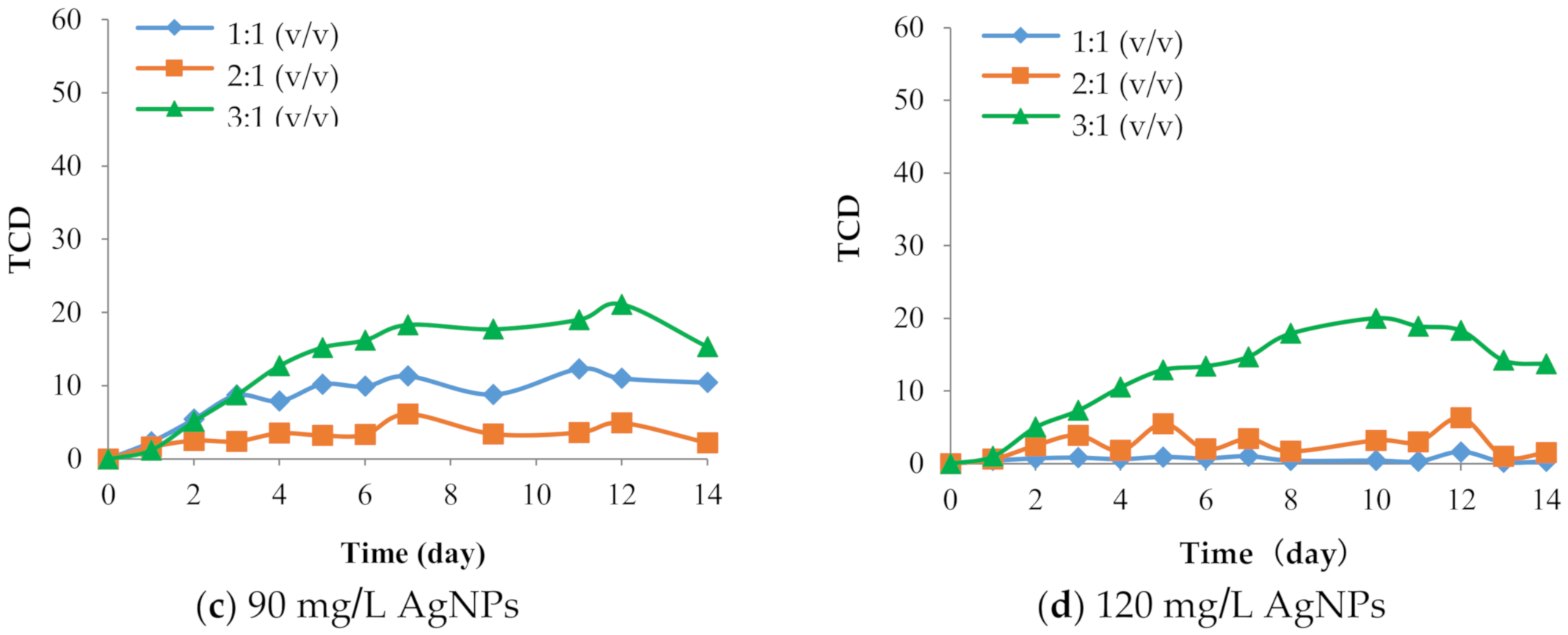
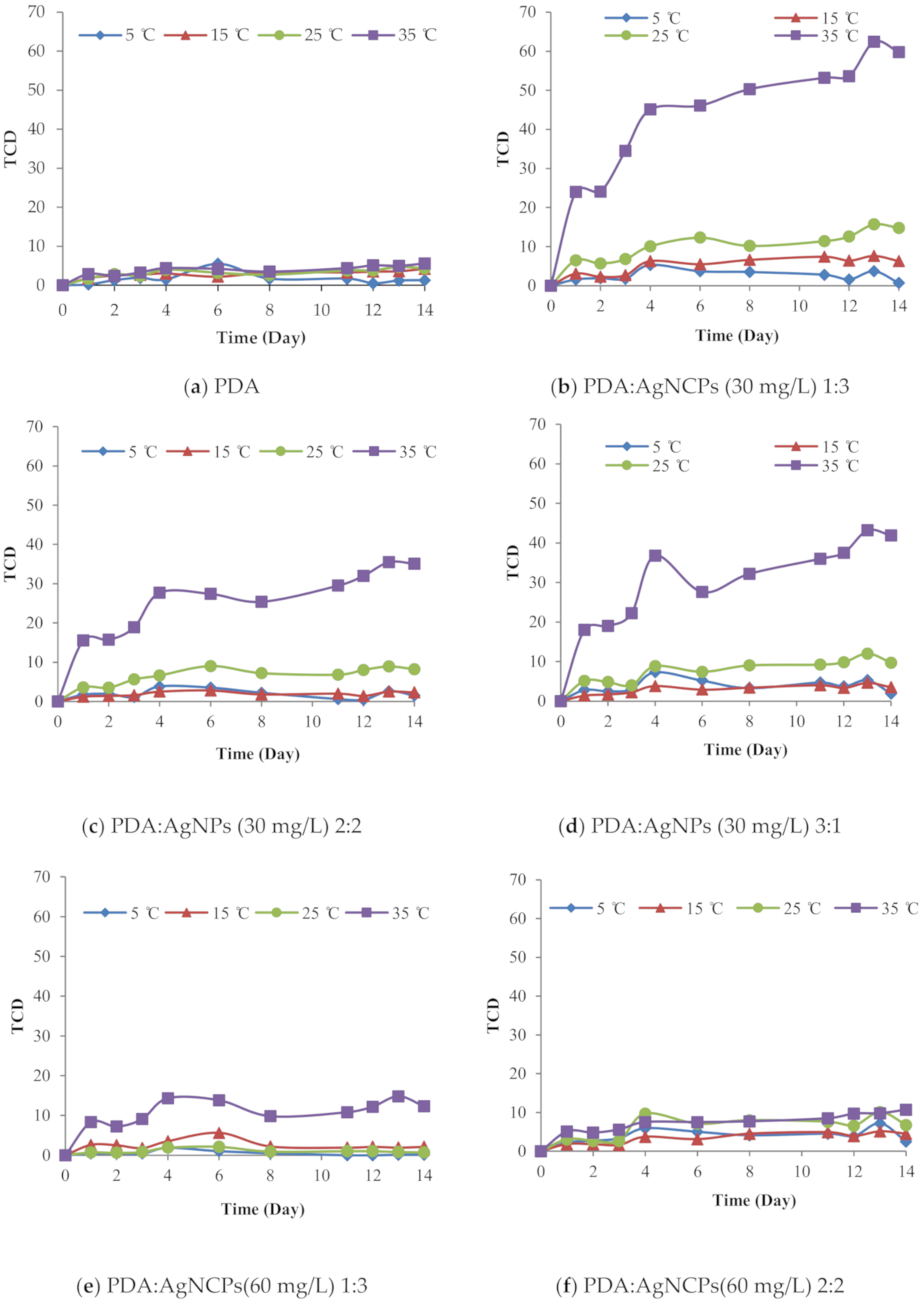
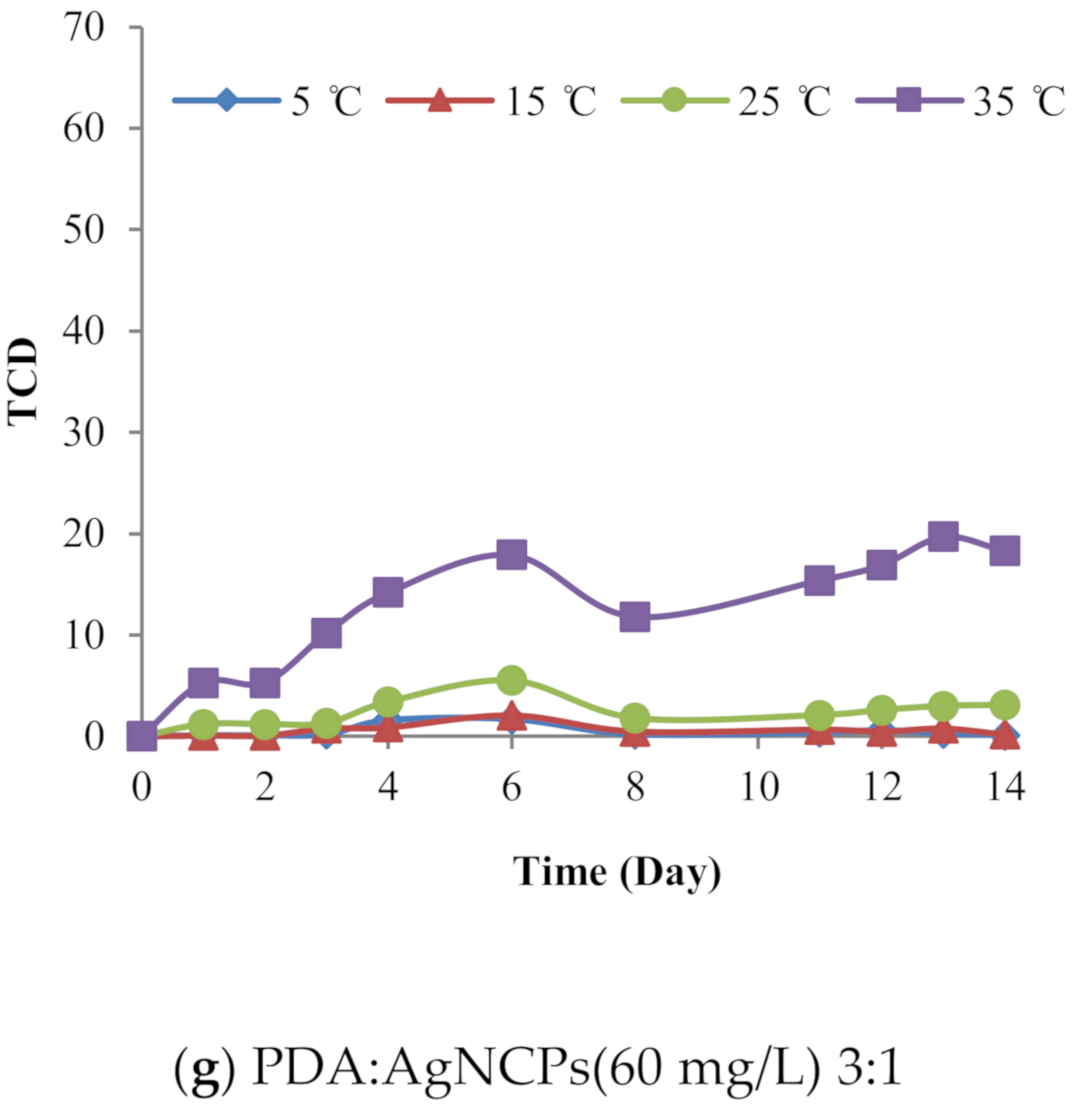


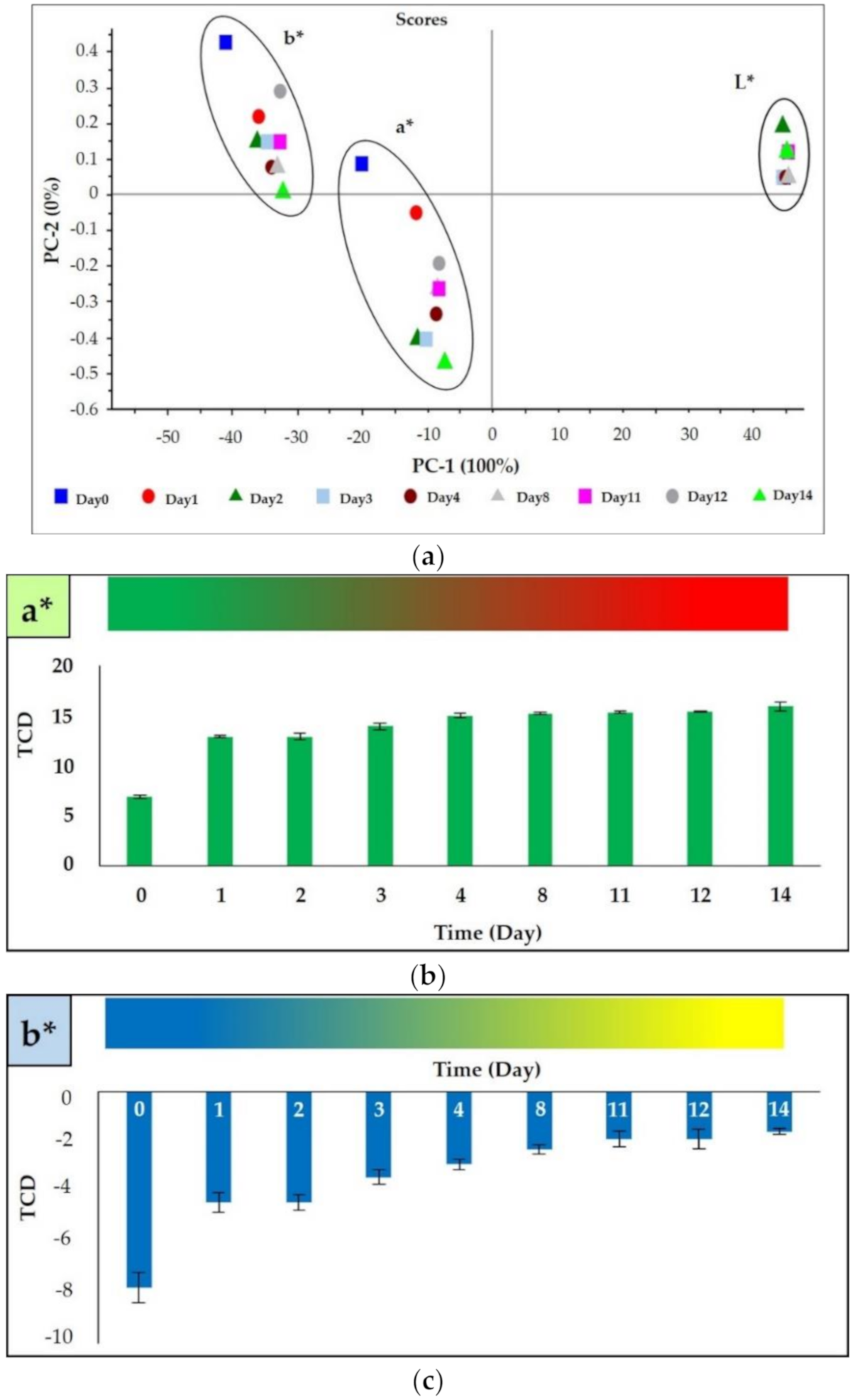
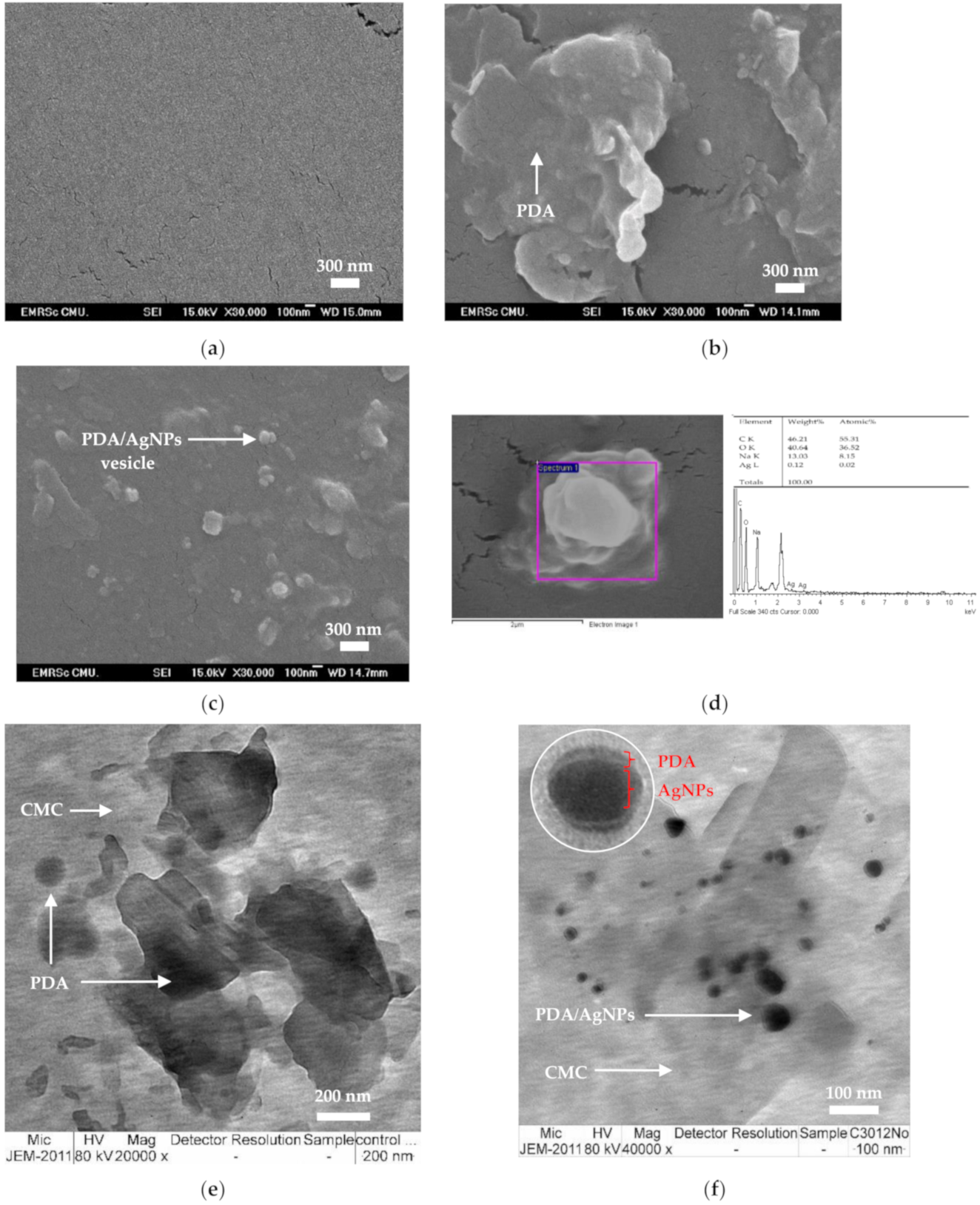
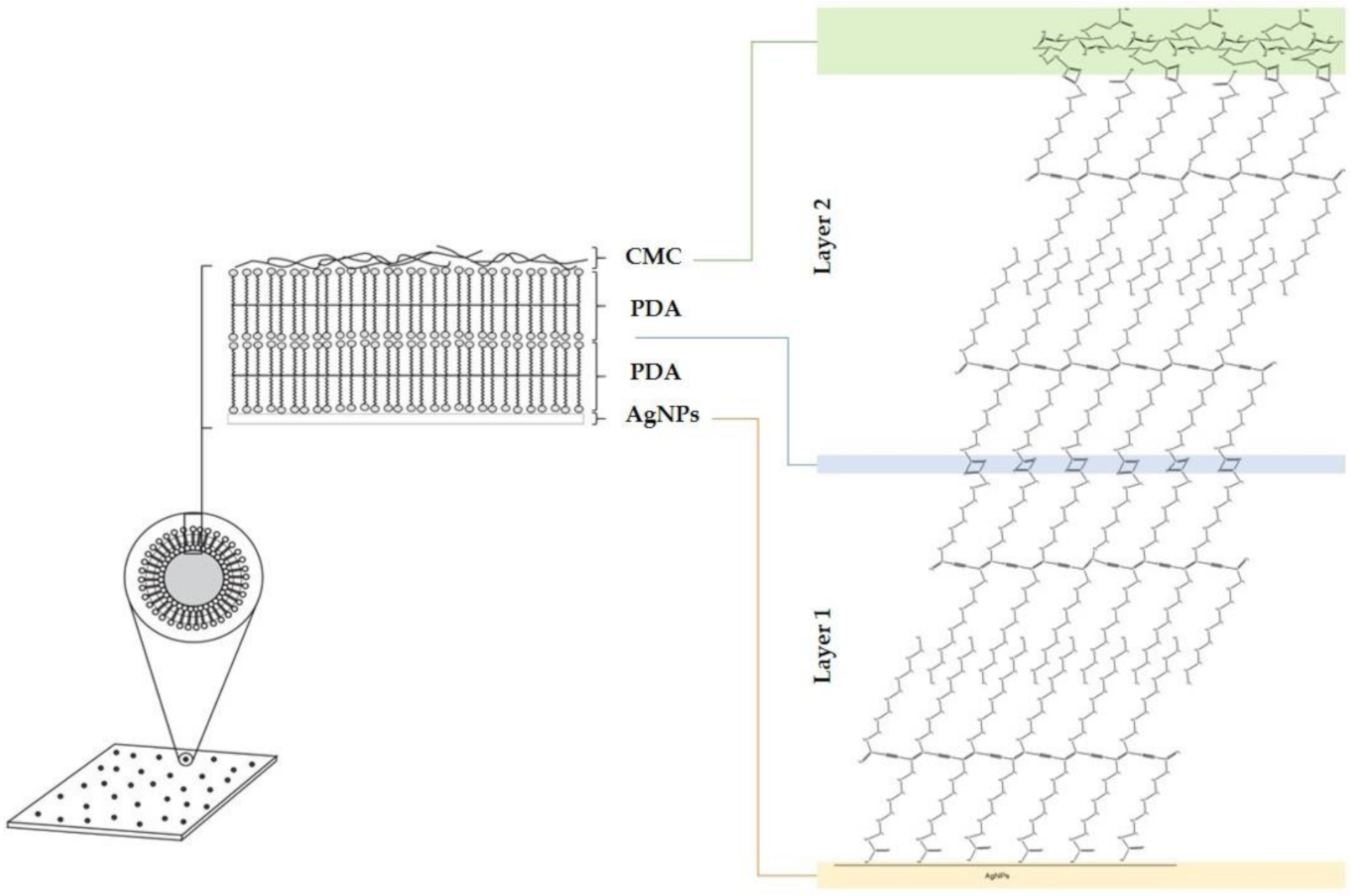
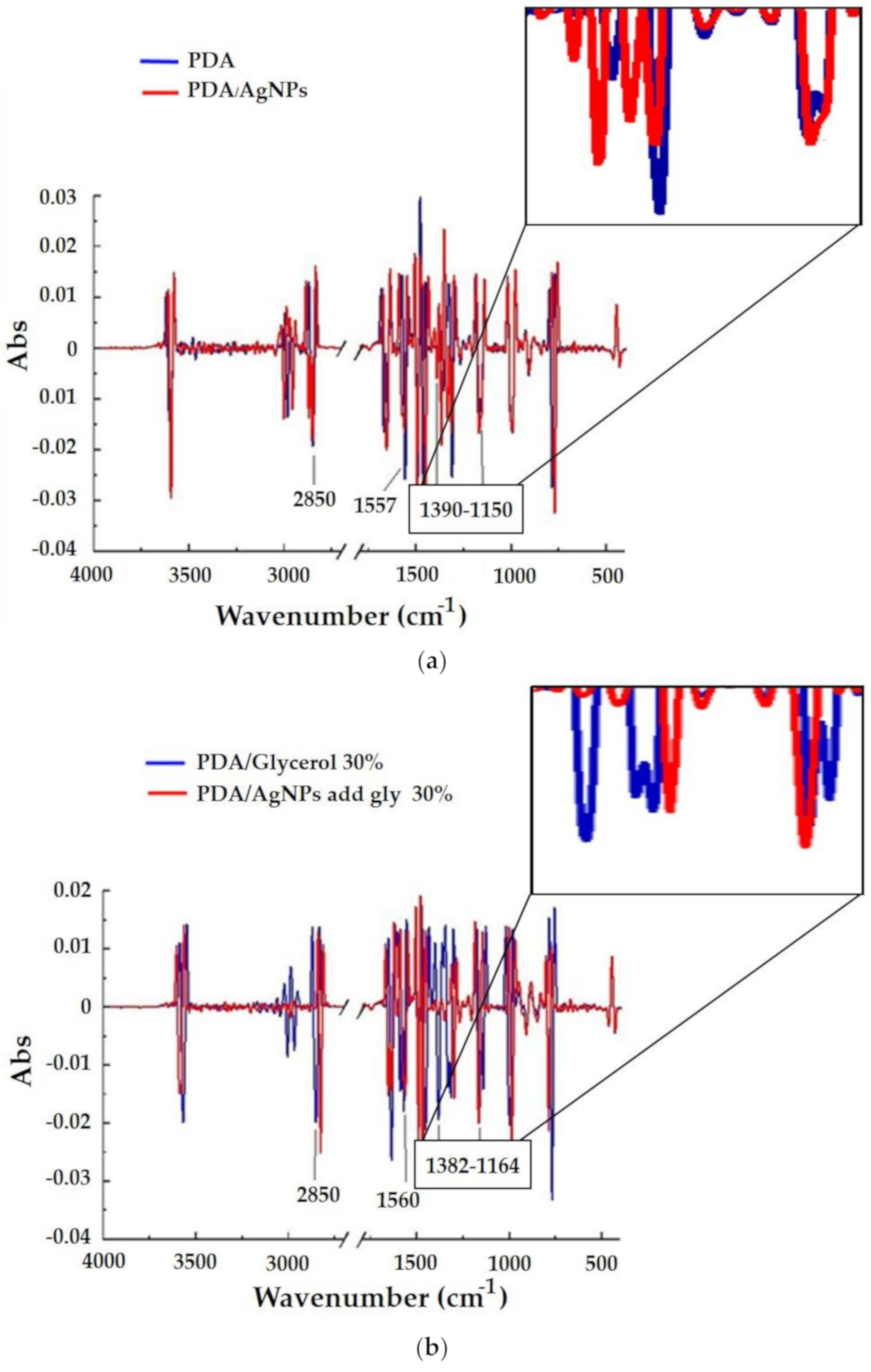
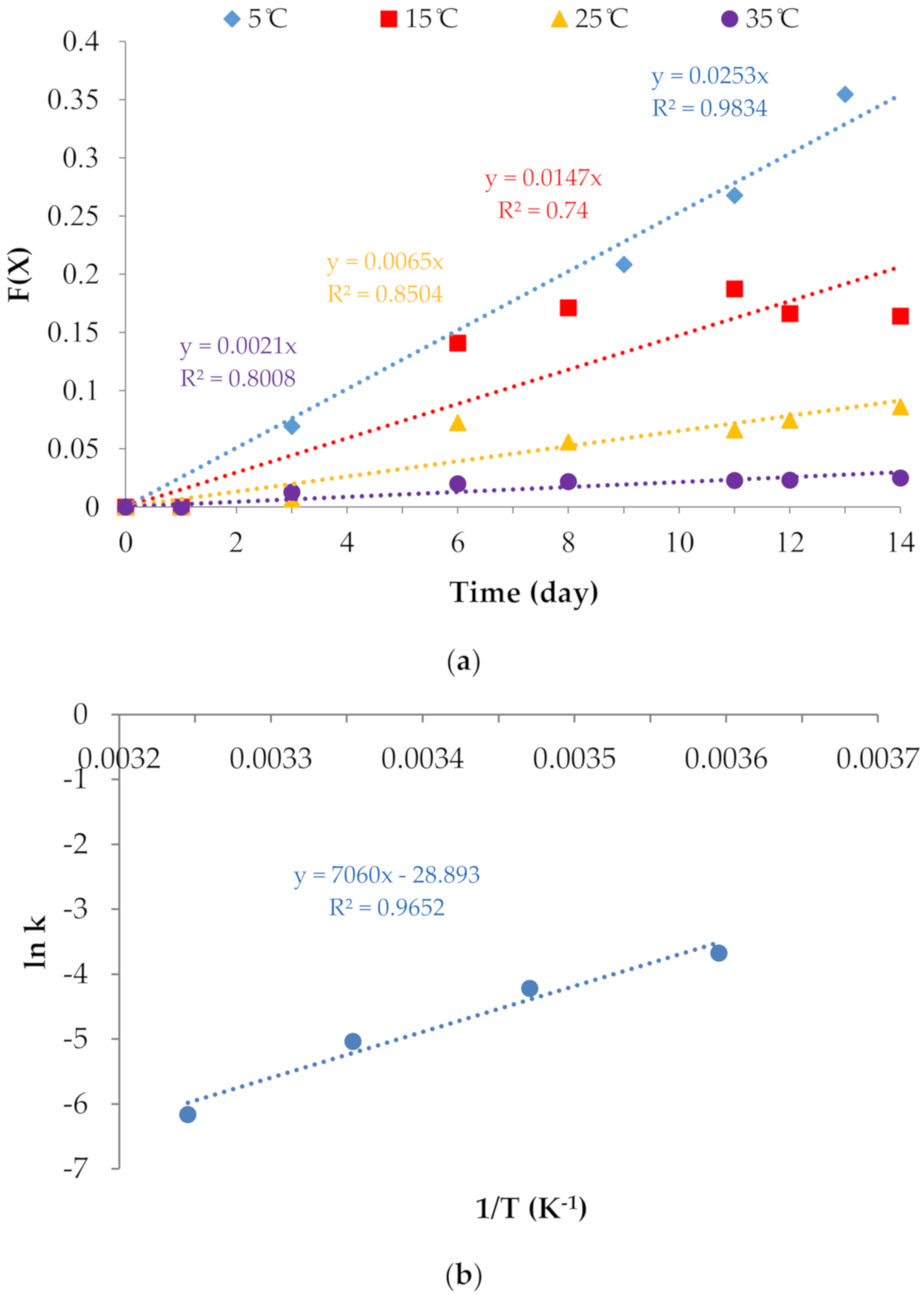
| CMC:PDA/AgNPs (Volume:Volume) | PDA (Volume) | AgNPs (Volume) | Concentration of AgNPs (mg/L) |
|---|---|---|---|
| 1:1 | 1 | 3 | 0, 30, 60, 90 and 120 |
| 2 | 2 | 0, 30, 60, 90 and 120 | |
| 3 | 1 | 0, 30, 60, 90 and 120 | |
| 2:1 | 1 | 3 | 0, 30, 60, 90 and 120 |
| 2 | 2 | 0, 30, 60, 90 and 120 | |
| 3 | 1 | 0, 30, 60, 90 and 120 | |
| 3:1 | 1 | 3 | 0, 30, 60, 90 and 120 |
| 2 | 2 | 0, 30, 60, 90 and 120 | |
| 3 | 1 | 0, 30, 60, 90 and 120 |
| Sample | Chemical Group | Wavenumber (cm−1) | References |
|---|---|---|---|
| PDA | CH2 from the alkyl chain conformation and the carboxyl-terminated | 2850 | [29] |
| PDA/AgNPs | C=O from carboxylic derivatives | 1560–1540 | [31] |
| PDA, PDA/AgNPs | CH2 from carbonyl group | 1400–1150 | [26,31] |
© 2020 by the authors. Licensee MDPI, Basel, Switzerland. This article is an open access article distributed under the terms and conditions of the Creative Commons Attribution (CC BY) license (http://creativecommons.org/licenses/by/4.0/).
Share and Cite
Saenjaiban, A.; Singtisan, T.; Suppakul, P.; Jantanasakulwong, K.; Punyodom, W.; Rachtanapun, P. Novel Color Change Film as a Time–Temperature Indicator Using Polydiacetylene/Silver Nanoparticles Embedded in Carboxymethyl Cellulose. Polymers 2020, 12, 2306. https://doi.org/10.3390/polym12102306
Saenjaiban A, Singtisan T, Suppakul P, Jantanasakulwong K, Punyodom W, Rachtanapun P. Novel Color Change Film as a Time–Temperature Indicator Using Polydiacetylene/Silver Nanoparticles Embedded in Carboxymethyl Cellulose. Polymers. 2020; 12(10):2306. https://doi.org/10.3390/polym12102306
Chicago/Turabian StyleSaenjaiban, Aphisit, Teeranuch Singtisan, Panuwat Suppakul, Kittisak Jantanasakulwong, Winita Punyodom, and Pornchai Rachtanapun. 2020. "Novel Color Change Film as a Time–Temperature Indicator Using Polydiacetylene/Silver Nanoparticles Embedded in Carboxymethyl Cellulose" Polymers 12, no. 10: 2306. https://doi.org/10.3390/polym12102306






